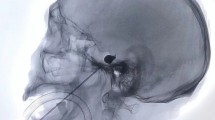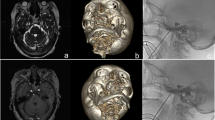Abstract
With the recent emergence of percutaneous balloon compression (PBC) as a promising treatment for trigeminal neuralgia (TN), there is a growing need for research on its safety and efficacy. This study was designed to evaluate the safety and efficacy of PBC in the treatment of TN patients during the perioperative period. This study involved a total of 400 TN patients who were selected and treated with PBC at our institution. The clinical data and short-term outcomes were analyzed based on sex, initial PBC treatment for TN, and subsequent PBC treatment for recurrent TN after previous PBC or microvascular decompression (MVD) or radiofrequency thermocoagulation (RFT). No statistically significant difference was found when comparing postoperative pain relief between male and female patients with TN. Nevertheless, female patients were found to be more vulnerable than male patients to abnormal facial sensations (P = 0.001), diplopia (P = 0.015), postoperative headache (P = 0.012), and hyposmia (P = 0.029). Additionally, it was observed that there was no substantial difference in the postoperative pain relief rate between the first-time PBC group and PBC for recurrent TN patients postoperatively following procedures such as PBC, MVD, and RFT. In conclusion, this study has shown that PBC treatment is effective in managing TN in both males and females, regardless of whether the treatment was administered as a primary intervention or following prior surgical procedures such as PBC, MVD, or RFT. Nonetheless, it is noted that the risk of postoperative complications appears to be higher in female patients compared to male patients.

Similar content being viewed by others
Data availability
No datasets were generated or analysed during the current study.
References
Tohyama S, Hung PS, Cheng JC, Zhang JY, Halawani A, Mikulis DJ, Oh J, Hodaie M (2020) Trigeminal neuralgia associated with a solitary pontine lesion: clinical and neuroimaging definition of a new syndrome. Pain 161(5):916–925. https://doi.org/10.1097/j.pain.0000000000001777
Di Stefano G, Truini A, Cruccu G (2018) Current and innovative pharmacological options to treat typical and atypical trigeminal neuralgia. Drugs 78(14):1433–1442. https://doi.org/10.1007/s40265-018-0964-9
Heinskou TB, Maarbjerg S, Wolfram F, Rochat P, Brennum J, Olesen J, Bendtsen L (2019) Favourable prognosis of trigeminal neuralgia when enrolled in a multidisciplinary management program - a two-year prospective real-life study. J Headache Pain 20(1):23. https://doi.org/10.1186/s10194-019-0973-4
Obermann M (2010) Treatment options in trigeminal neuralgia. Ther Adv Neurol Disord 3(2):107–115. https://doi.org/10.1177/1756285609359317
Urgosik D, Liscak R, Novotny J Jr, Vymazal J, Vladyka V (2005) Treatment of essential trigeminal neuralgia with gamma knife surgery. J Neurosurg 102:29–33. https://doi.org/10.3171/jns.2005.102.s_supplement.0029
Andersen ASS, Heinskou TB, Rochat P, Springborg JB, Noory N, Smilkov EA, Bendtsen L, Maarbjerg S (2022) Microvascular decompression in trigeminal neuralgia - a prospective study of 115 patients. J Headache Pain 23(1):145. https://doi.org/10.1186/s10194-022-01520-x
Garcia-Isidoro S, Castellanos-Sanchez VO, Iglesias-Lopez E, Perpiña-Martinez S (2021) Invasive and non-invasive electrical neuromodulation in trigeminal nerve neuralgia: a systematic review and Meta-analysis. Curr Neuropharmacol 19(3):320–333. https://doi.org/10.2174/1570159X18666200729091314
Li F, Han S, Ma Y, Yi F, Xu X, Liu Y (2014) Optimal duration of percutaneous microballoon compression for treatment of trigeminal nerve injury. Neural Regeneration Res 9(2):179–189. https://doi.org/10.4103/1673-5374.125347
Santos VS, Santana JC, Castro FD, Oliveira LS, Santana JC, Feitosa VL, Gurgel RQ, Cuevas LE (2016) Pain and quality of life in leprosy patients in an endemic area of Northeast Brazil: a cross-sectional study. Infect Dis Poverty 5:18. https://doi.org/10.1186/s40249-016-0113-1
Young JC, Wu JM, Willis-Gray M, Pate V, Jonsson Funk M (2020) Persistent opioid use after hysterectomy in the United States, 2005–2015. Obstet Gynecol 135(1):123–132. https://doi.org/10.1097/AOG.0000000000003612
Liu KS, Kao CW, Tseng YY, Chen SK, Lin YT, Lu CJ, Liu SJ (2021) Assessment of Antimicrobial Agents, Analgesics, and Epidermal Growth Factors-Embedded Anti-Adhesive Poly(Lactic-Co-Glycolic Acid) Nanofibrous Membranes: In vitro and in vivo Studies. International journal of nanomedicine 16, 4471–4480. https://doi.org/10.2147/IJN.S318083
Zheng X, Feng X, Cai XJ (2016) Effectiveness and safety of continuous wound infiltration for postoperative pain management after open gastrectomy. World J Gastroenterol 22(5):1902–1910. https://doi.org/10.3748/wjg.v22.i5.1902
Xu B, Liu SS, Wei J, Jiao ZY, Mo C, Lv CM, Huang AL, Chen QB, Ma L, Guan XH (2020) Role of spinal cord Akt-mTOR signaling pathways in postoperative Hyperalgesia Induced by Plantar Incision in mice. Front NeuroSci 14:766. https://doi.org/10.3389/fnins.2020.00766
Mao Z, Wen T, Liu X, Chen J, Hu P, Liu C, Liu H, Kang H, Zhang Z, Zhou F (2022) Geriatric nutritional risk index is Associated with Hospital Death in Elderly patients with multiple organ dysfunction syndrome: a retrospective study based on the MIMIC-III database. Front Nutr 9:834256. https://doi.org/10.3389/fnut.2022.834256
Eslami V, Katz MJ, White RS, Sundermann E, Jiang JM, Ezzati A, Lipton RB (2017) Pain Intensity and Pain Interference in older adults: role of gender, obesity and high-sensitivity C-Reactive protein. Gerontology 63(1):3–12. https://doi.org/10.1159/000446651
Ge X, Wang L, Pan L, Ye H, Zhu X, Fan S, Feng Q, Yu W, Ding Z (2022) Amplitude of low-frequency fluctuation after a single-trigger pain in patients with classical trigeminal neuralgia. J Headache Pain 23(1):117. https://doi.org/10.1186/s10194-022-01488-8
Zheng S, Yuan R, Ni J, Liu H, Yang Y, Zhang S, Li J (2022) Long-term recurrence-free survival and complications of percutaneous balloon compression and radiofrequency thermocoagulation of gasserian ganglion for trigeminal neuralgia: a retrospective study of 1313 cases. Pain Practice: Official J World Inst Pain 22(5):532–540. https://doi.org/10.1111/papr.13114
Headache Classification Committee of the International Headache Society (IHS) The International Classification of Headache Disorders, 3rd edition (2018) Cephalalgia: an international journal of headache 38(1), 1–211. https://doi.org/10.1177/0333102417738202
Mullan S, Lichtor T (1983) Percutaneous microcompression of the trigeminal ganglion for trigeminal neuralgia. J Neurosurg 59(6):1007–1012. https://doi.org/10.3171/jns.1983.59.6.1007
Wang CM, Guan ZY, Zhang J, Cai CH, Pang QG, Wang RW, Liu H, Liu YF, Yin MH, Ma Y (2015) Comparative study of trigeminocardiac reflex after trigeminal ganglion compression during total intravenous anesthesia. J Neurosurg Anesthesiol 27(1):16–20. https://doi.org/10.1097/ANA.0000000000000076
Rogers CL, Shetter AG, Fiedler JA, Smith KA, Han PP, Speiser BL (2000) Gamma knife radiosurgery for trigeminal neuralgia: the initial experience of the Barrow Neurological Institute. Int J Radiat Oncol Biol Phys 47(4):1013–1019. https://doi.org/10.1016/s0360-3016(00)00513-7
Fan X, Xu F, Ren H, Lu Z, Bu H, Ma L, Kong C, Wang T (2021) The analysis of Percutaneous Balloon Compression on Efficacy and negative emotion in the treatment of recurrent trigeminal Neuralgia after Surgical procedures. Pain Physician 24(8):E1255–E1262
Sun C, Zheng W, Zhu Q, Du Q, Yu W (2022) The pros and cons of multiple puncture in percutaneous balloon compression for treatment of trigeminal neuralgia. Front Neurol 13:1034133. https://doi.org/10.3389/fneur.2022.1034133
Wang JY, Bender MT, Bettegowda C (2016) Percutaneous procedures for the treatment of trigeminal Neuralgia. Neurosurg Clin North Am 27(3):277–295. https://doi.org/10.1016/j.nec.2016.02.005
Kouzounias K, Schechtmann G, Lind G, Winter J, Linderoth B (2010) Factors that influence outcome of percutaneous balloon compression in the treatment of trigeminal neuralgia. Neurosurgery 67(4):925–934. https://doi.org/10.1227/NEU.0b0. 13e3181 e b5230
Skirving DJ, Dan NG (2001) A 20-year review of percutaneous balloon compression of the trigeminal ganglion. J Neurosurg 94(6):913–917. https://doi.org/10.3171/jns.2001.94.6.0913
Lone PA, Wani NA, Ain QU, Heer A, Devi R, Mahajan S (2021) Common postoperative complications after general anesthesia in oral and maxillofacial surgery. Natl J Maxillofacial Surg 12(2):206–210. https://doi.org/10.4103/njms.NJMS_66_20
Asplund P, Linderoth B, Bergenheim AT (2010) The predictive power of balloon shape and change of sensory functions on outcome of percutaneous balloon compression for trigeminal neuralgia. J Neurosurg 113(3):498–507. https://doi.org/10.3171/2010.2.JNS091466
Wang Q, Chen C, Guo G, Li Z, Huang D, Zhou H (2021) A Prospective Study to Examine the Association of the Foramen Ovale Size with Intraluminal pressure of Pear-shaped balloon in Percutaneous Balloon Compression for Trigeminal Neuralgia. Pain Therapy 10(2):1439–1450. https://doi.org/10.1007/s40122-021-00311-7
Zhang H, Lian Y, Ma Y, Chen Y, He C, Xie N, Wu C (2014) Two doses of botulinum toxin type A for the treatment of trigeminal neuralgia: observation of therapeutic effect from a randomized, double-blind, placebo-controlled trial. J Headache Pain 15(1):65. https://doi.org/10.1186/1129-2377-15-65
Omeis I, Smith D, Kim S, Murali R (2008) Percutaneous balloon compression for the treatment of recurrent trigeminal neuralgia: long-term outcome in 29 patients. Stereotact Funct Neurosurg 86(4):259–265. https://doi.org/10.1159/000138770
Chen JF, Tu PH, Lee ST (2012) Repeated percutaneous balloon compression for recurrent trigeminal neuralgia: a long-term study. World Neurosurg 77(2):352–356. https://doi.org/10.1016/j.wneu.2011.06.013
Chen JN, Yu WH, Du HG, Jiang L, Dong XQ, Cao J (2018) Prospective comparison of Redo Microvascular Decompression and Percutaneous Balloon Compression as primary surgery for recurrent trigeminal neuralgia. J Korean Neurosurg Soc 61(6):747–752. https://doi.org/10.3340/jkns.2017.0196
Bakker NA, Van Dijk JM, Immenga S, Wagemakers M, Metzemaekers JD (2014) Repeat microvascular decompression for recurrent idiopathic trigeminal neuralgia. J Neurosurg 121(4):936–939. https://doi.org/10.3171/2014.7.JNS132667
Liu L, Sun Z, Zhang Y, Ma G, Luo F (2022) Predictors of response for percutaneous balloon compression for the treatment of recurrent trigeminal neuralgia following surgical procedures: a retrospective study. Neurosurg Rev 45(5):3447–3455. https://doi.org/10.1007/s10143-022-01852-x
Acknowledgements
We express our gratitude to participants and researchers in this study.
Funding
This study was supported by Liaoning Natural Science Foundation of China (No. 2020-MS-053).
Author information
Authors and Affiliations
Contributions
All authors contributed to the study conception and design. The work was designed by C.W. and K.Z. Material preparation and data collection were performed by Q.T., H.H., Y.L. and Y.M. The interpretation of data was performed by J.Z. and C.W. The first draft of the manuscript was written by Q.T. and S.G., and all authors commented on the previous versions of the manuscript. All authors read and approved the final manuscript.
Corresponding authors
Ethics declarations
Ethical approval
This study was performed in line with the principles of the Declaration of Helsinki. All research procedures were approved by the Institutional Research Review Board and the Research Ethics Committee of The People’s Hospital of Liaoning Province. Patient’s personal sensitive information has been anonymized and deidentifed.
Consent to participate
All patients who participated in the study signed informed consent.
Competing interests
The authors declare no competing interests.
Additional information
Publisher’s Note
Springer Nature remains neutral with regard to jurisdictional claims in published maps and institutional affiliations.
Rights and permissions
Springer Nature or its licensor (e.g. a society or other partner) holds exclusive rights to this article under a publishing agreement with the author(s) or other rightsholder(s); author self-archiving of the accepted manuscript version of this article is solely governed by the terms of such publishing agreement and applicable law.
About this article
Cite this article
Tang, Q., Gao, S., Wang, C. et al. A prospective cohort study on perioperative percutaneous balloon compression for trigeminal neuralgia: safety and efficacy analysis. Neurosurg Rev 47, 86 (2024). https://doi.org/10.1007/s10143-024-02323-1
Received:
Revised:
Accepted:
Published:
DOI: https://doi.org/10.1007/s10143-024-02323-1




